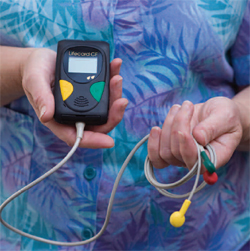 A day spent in the company of a Holter Monitor won’t be the most enchanting 24-hours you have ever spent, but it won’t hurt a bit and it could save your life.
A day spent in the company of a Holter Monitor won’t be the most enchanting 24-hours you have ever spent, but it won’t hurt a bit and it could save your life.
If your physician mentions a Holter Monitor, you will be excused for having no idea what he or she is talking about. But, to clarify this, the monitor is a piece of equipment approximately the size of a cell phone, with cables that connect to the chest area, similar to an ECG. The device is designed to track the rhythms of the heart over a 24-hour period – much longer than the standard ECG is capable of doing. The monitors track the heart’s electrical system, checking for abnormalities and being able to detect life-threatening arrhythmias, those heartbeat irregularities that demonstrate signs of previous heart malfunctions.
With its extended duration function, the Holter Monitor can be the first step in diagnosing the need for a pacemaker or drug therapy to reduce the risk of such complications as strokes.
Currently there is a wait list of up to four weeks because of the increased need for testing. The addition of the two new monitors that were purchased last year has allowed the Laboratory to increase the capacity and keep up with the need. The addition of another two monitors would help to shorten wait times to a more acceptable level Cardiology technologists see about 30 patients a week, and two more monitors will address the patient needs that accompany the growing influx of seniors into the community.
It is the generous support of the community that makes all of this possible. Donations made to the St. Joseph’s Hospital Foundation by service clubs and individuals help make the best possible healthcare available for the community.
With the generous support from Knights of Columbus, RBC Foundation, Strathcona Sunrise Rotary Club, Quality Foods and the Comox Legion we purchased five new holter monitors in the last 18 months.






Leave A Comment